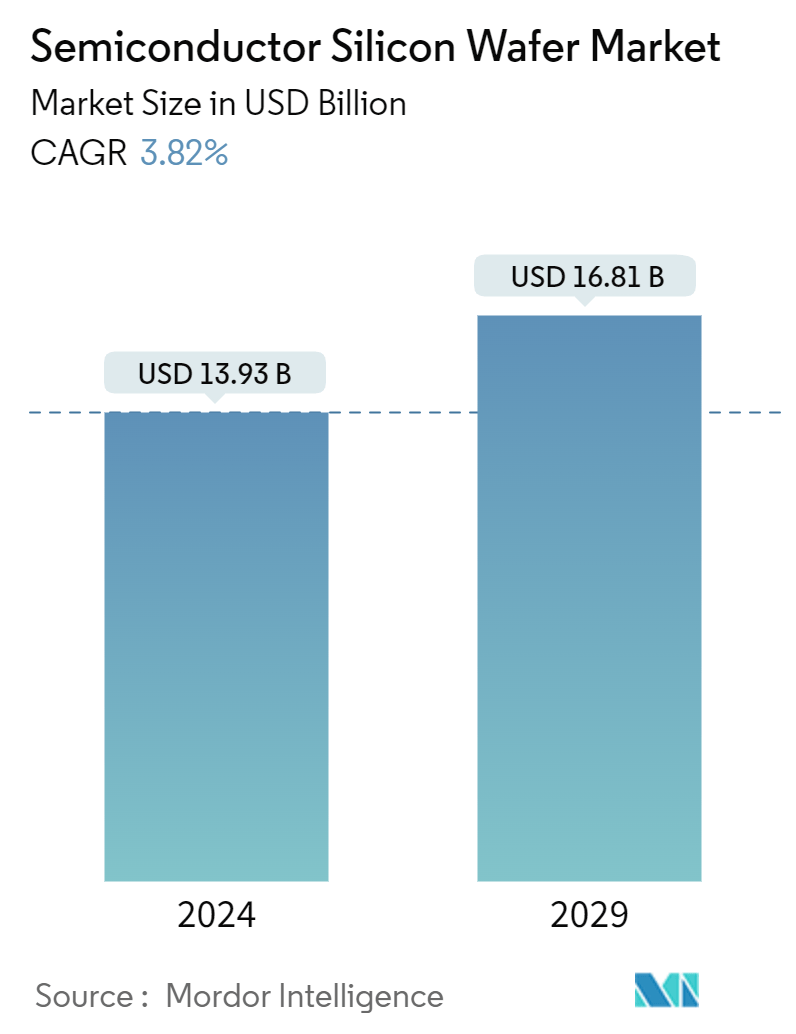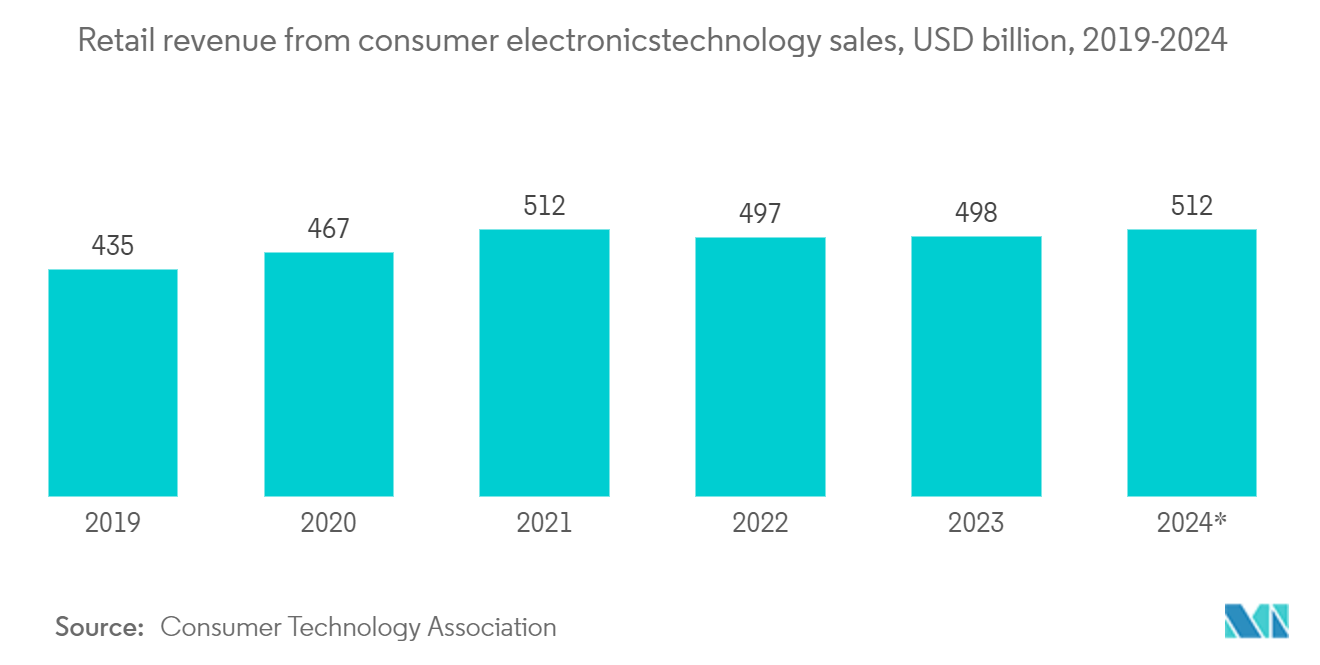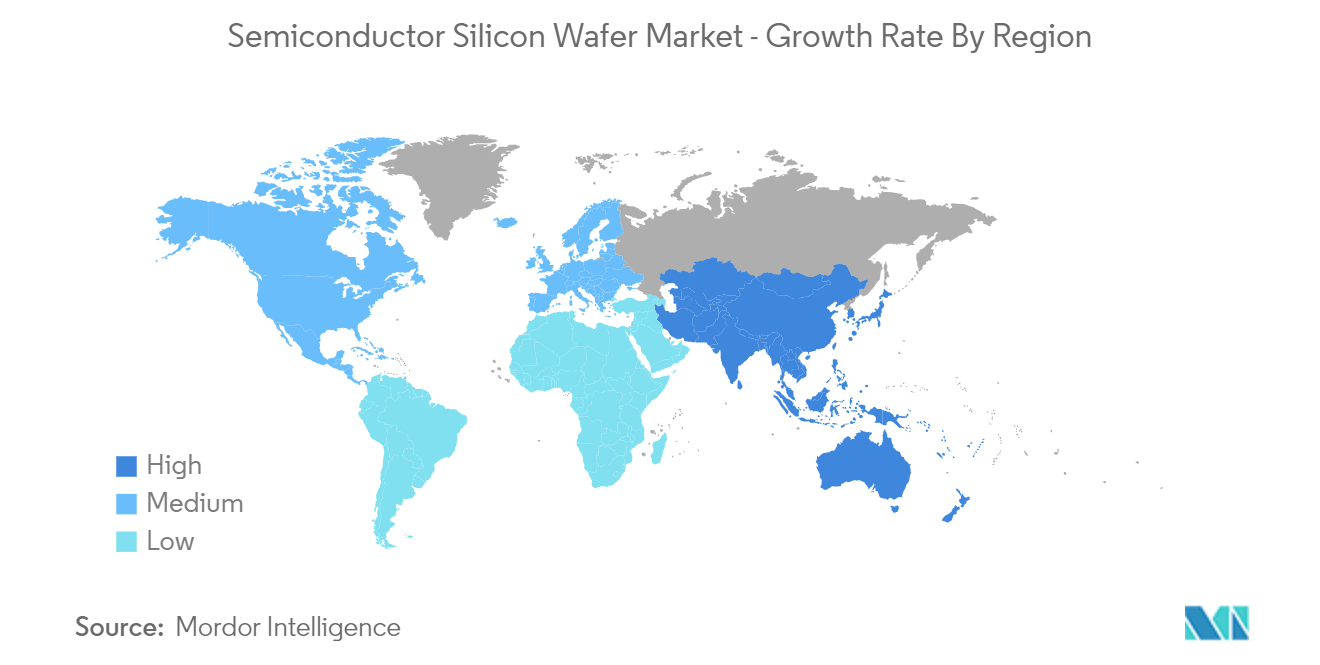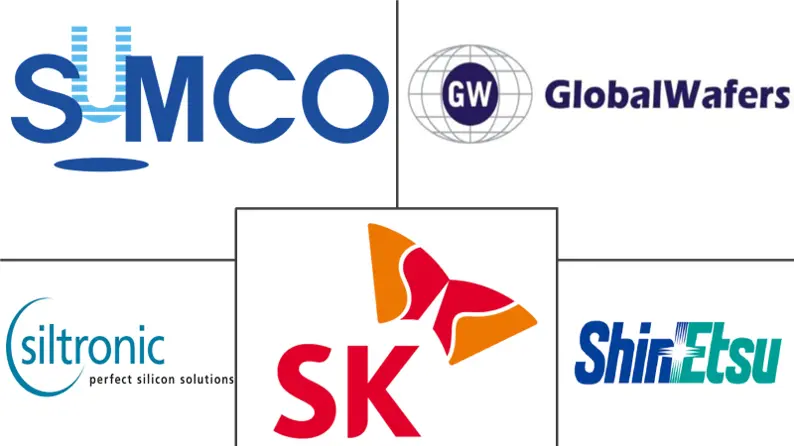Semiconductor Silicon Wafer Market Size

| Study Period | 2019 - 2029 |
| Market Size (2024) | USD 13.93 Billion |
| Market Size (2029) | USD 16.81 Billion |
| CAGR (2024 - 2029) | 3.82 % |
| Fastest Growing Market | Asia Pacific |
| Largest Market | Asia Pacific |
Major Players*Disclaimer: Major Players sorted in no particular order |
Semiconductor Silicon Wafer Market Analysis
The Semiconductor Silicon Wafer Market size is estimated at USD 13.93 billion in 2024, and is expected to reach USD 16.81 billion by 2029, growing at a CAGR of 3.82% during the forecast period (2024-2029).
The Semiconductor Silicon Wafer Market size is estimated at USD 13.93 billion in 2024, and is expected to reach USD 16.81 billion by 2029, growing at a CAGR of 3.82% during the forecast period (2024-2029).
- Semiconductor silicon wafer remains the core component of many microelectronic devices and forms the cornerstone of the electronics industry. With digitization and electronic mobility being the current trends in the technology landscape, these products are finding applications in many devices. Also, the demand for small-sized gadgets has increased the need for more functionalities from a single device. This means that an IC chip should now house more transistors to support more features.
- The semiconductor industry has been a significant driver behind critical innovations in significant sectors like electronics, automobiles, and automation, with semiconductor technology emerging as the building block of all modern technologies. The advancements and innovations in this field are immediately impacting all downstream technologies.
- Foundries are increasingly investing in new advanced packaging techniques, especially silicon wafer-based. Foundry vendors are researching improving transistor density with techniques like utilizing two-dimensional materials instead of silicon as the channel to develop Monolithic 3D Integrated Circuits. For instance, TSMC's chip on wafer on Substrate technology developed the world's largest silicon interposer that featuring room for two massive processors combined with 8 HBM memory devices in a package.
- Advancements in wearable devices will create massive growth opportunities for market vendors. According to Siemens, industrial wearables could be a massive market as these devices enhance quality and safety in the processing industry. According to Zebra Technologies Corporation, 40-50% of manufacturers globally are expected to adopt wearables by 2022. Also, the demand for small-sized gadgets has raised the need for more functionalities from a single device. This indicates that an IC chip should now house more transistors to support more functionalities.
- Favorable government policies across emerging economies like China created enormous opportunities for the semiconductor industry, which is expected to expand the semiconductor silicon wafer market during the forecast period. For instance, the policy framework published by the State Council of the People's Republic of China aims to make advanced semiconductor packaging solutions a technology priority across the semiconductor industry.
Semiconductor Silicon Wafer Market Trends
The Consumer Electronics Segment is Expected to Occupy a Significant Market Share
- In the current market scenario, many electronic devices, including laptops, smartphones, computers, etc., still use ICs and other semiconductor devices manufactured from silicon substances. Although silicon is still dominating primary applications in the consumer electronics market, new materials have replaced the previous substrates and packaging for a few uses.
- According to the Consumer Technology Association's (CTA) 'US Consumer Technology Sales and Forecast' study, CTA expects that 5G-enabled smartphone devices will reach 2.1 million units and cross USD 1.9 billion in revenue with triple-digit increases through 2021. Apple announced a contribution of USD 350 billion to the US economy by 2023 and promised 2.4 million jobs over the next five years, which comprises new investments and its existing spending with domestic companies for supply and manufacturing. The company is a prominent player in the consumer electronics industry. Hence, the announcement is expected to propel the demand for semiconductor silicon wafers.
- Recently, the Singapore-MIT Alliance for Research and Technology (SMART), MIT's research enterprise in Singapore, announced the successful development of a commercially viable way to manufacture integrated silicon III-V chips with powerful performance III-V devices inserted into their design.
- In most devices nowadays, silicon-based CMOS chips are primarily used for computing, but they are not efficient for communications and illumination, resulting in low efficiency and heat generation. Thus, current 5G mobile devices on the market get very hot upon use and shut down after a short time. However, combining III-V semiconductor devices with silicon in a commercially viable way is one of the most complex challenges the semiconductor industry faces.

North America is Expected to Hold a Significant Share
- North America is expected to be a significant revenue contributor to the market by 2021, as fabless semiconductor companies are the prominent customers for semiconductor foundries and wafer players. Fabless companies make chip designs exclusively and market them without a fabrication plant.
- The major fabless companies in the region are AMD, Broadcom, Apple, Qualcomm, Marvell, NVIDIA, and Xilinx. North America has presented a crucial role in advanced semiconductor system design and manufacturing. The region has been witnessing increased activity in establishing semiconductor wafer foundries. TSMC announced that it would spend a total of USD 12 billion from 2021 to 2029 to build a 12-inch wafer plant to manufacture chips using the advanced 5 nm process. Moreover, tech supply chains will continue to shift even after Donald Trump, who pressed foreign companies to invest and create jobs in America, was defected by Joe Biden.
- The electronics industry in the region has been growing steadily and holds a prominent share in several enterprises operating in the design and fabless space. According to the US Census Bureau, the industry revenue of semiconductors and other electronic components in the United States during 2019 stood at USD 100.08 billion, and it is expected to reach USD 105.16 billion by 2023. Smartphones are among the most significant contributors to semiconductor consumption in the consumer electronics sector. In recent years, the region has witnessed consistent growth in smartphone sales.
- Moreover, the United States is home to some of the world's major automotive players, which are investing in electric vehicles and the self-driving potential of cars, which demand high-performance ICs. This is one of the major factors driving the demand for the semiconductor silicon wafers market.

Semiconductor Silicon Wafer Industry Overview
The Semiconductor Silicon Wafer Market is quite competitive. In terms of market share, only a few players dominate the current market, due to which the market is quite consolidated. However, players' upcoming technologies and the innovations carried out are the reason behind the significant boost in the semiconductor silicon wafers market. The market is even witnessing multiple mergers and partnerships so that the companies expand their geographical presence.
- January 2024 - Wolfspeed, Inc., a provider in silicon carbide technology, announced today that it has significantly expanded its ongoing silicon carbide wafer supply deal with a major global semiconductor entity. Valued at around USD 275 million, this enhanced agreement mandates Wolfspeed to provide the company with 150mm silicon carbide bare and epitaxial wafers. This move underscores both firms' commitment to steering the industry towards adopting silicon carbide semiconductor power devices over traditional silicon.
- August 2023 - Nidec Instruments Corporation (“Nidec Instruments”), a fully owned subsidiary of Nidec corporation, announced the launch of its latest semiconductor wafer transfer robot.
Semiconductor Silicon Wafer Market Leaders
-
Shin-Etsu Handotai
-
Siltronic AG
-
SUMCO Corporation
-
SK Siltron Co. Ltd
-
Globalwafers Co. Ltd
*Disclaimer: Major Players sorted in no particular order

Semiconductor Silicon Wafer Market News
- In February 2024, the Government of India approved Tata Electronics' proposal to establish a significant semiconductor fabrication facility ("Fab") in Dholera, Gujarat, in collaboration with PSMC. This Fab is slated to produce a maximum of 50,000 wafers monthly, boasting cutting-edge factory automation. Leveraging data analytics and machine learning, the facility aims to set new benchmarks in factory efficiency.
- In June 2024, Vanguard International Semiconductor Corporation (VIS), a Taiwanese IC foundry service provider, and NXP Semiconductors N.V., a prominent Dutch semiconductor manufacturer, unveiled their collaboration to construct a cutting-edge semiconductor wafer manufacturing facility in Singapore. This venture, valued at USD 7.8 billion, will focus on producing 130nm to 40nm mixed-signal, power management, and analog products. The facility's offerings are tailored for a diverse range of sectors, including automotive, industrial, consumer electronics, and mobile devices.
Semiconductor Silicon Wafer Market Report - Table of Contents
1. INTRODUCTION
- 1.1 Study Assumptions and Market Definition
- 1.2 Scope of the Study
2. EXECUTIVE SUMMARY
3. RESEARCH METHODOLOGY
4. MARKET DYNAMICS
- 4.1 Market Overview
- 4.2 Industry Value Chain Analysis
-
4.3 Industry Attractiveness - Porter's Five Forces Analysis
- 4.3.1 Bargaining Power of Suppliers
- 4.3.2 Bargaining Power of Consumers
- 4.3.3 Threat of New Entrants
- 4.3.4 Threat of Substitute Products
- 4.3.5 Intensity of Competitive Rivalry
-
4.4 Market Drivers
- 4.4.1 Growing Demand from Non-Traditional End-User Verticals and Steady Rise in Wearable Sales
-
4.5 Market Challenges
- 4.5.1 Operational Challenges Faced by the Producers Owing to High Cost and Dynamic Nature of End-User Demand
- 4.6 Key Cost Considerations for Silicon Wafer
- 4.7 Impact of COVID-19 on the Semiconductor Silicon Wafer Industry
5. MARKET SEGMENTATION
-
5.1 By Diameter
- 5.1.1 Less than 150 mm
- 5.1.1.1 By Product (Logic, Memory, Analog, and Other Products)
- 5.1.1.2 Vendor Ranking Analysis
- 5.1.2 200 mm
- 5.1.3 300 mm and above (450mm, etc.)
-
5.2 By Product
- 5.2.1 Logic
- 5.2.2 Memory
- 5.2.3 Analog
- 5.2.4 Other Products
-
5.3 By Application
- 5.3.1 Consumer Electronics
- 5.3.1.1 Mobile/Smartphones
- 5.3.1.2 Desktop, Notebook, and Server PCs
- 5.3.2 Industrial
- 5.3.3 Telecommunication
- 5.3.4 Automotive
- 5.3.5 Other Applications
-
5.4 By Geography
- 5.4.1 North America
- 5.4.2 Europe
- 5.4.3 Asia
- 5.4.4 Australia and New Zealand
6. COMPETITIVE LANDSCAPE
-
6.1 Company Profiles
- 6.1.1 Shin-Etsu Handotai
- 6.1.2 Siltronic AG
- 6.1.3 SUMCO Corporation
- 6.1.4 SK Siltron Co. Ltd
- 6.1.5 Globalwafers Co.Ltd
- 6.1.6 SOITEC SA
- 6.1.7 Okmetic Inc.
- 6.1.8 Wafer Works Corporation
- 6.1.9 Episil-Precision Inc.
- *List Not Exhaustive
7. ANALYSIS OF KEY CHINESE VENDORS AND STAKEHOLDERS
- 7.1 Zing Semiconductor Corporation (Shanghai)
- 7.2 MCL Electronic Material Limited
- 7.3 GrinM Semiconductor Materials Limited
- 7.4 Shanghai Simgui Technology Co. Limited
- 7.5 Ferrotec (Hangzhou & Shenhe FTS)
- 7.6 Zhonghuan Semiconductor Corporation
8. INVESTMENT ANALYSIS
9. FUTURE OF THE MARKET
** Subject To AvailablitySemiconductor Silicon Wafer Industry Segmentation
Silicon wafers are thin slices of pure or doped silicon cut from silicon ingots. Their thicknesses range from a few millimeters to a few microns and can be tuned according to the application through thinning processes. They are extensively used in smartphones, smartwatches, computers, tablets, gas sensors, and smart home sensors.
The semiconductor silicon wafer market is segmented by diameter (less than 150 mm, 200 mm, 300 mm, and above), product (logic, memory, and analog), application (consumer electronics, industrial, telecommunication, and automotive), and geography. The market sizes and forecasts are provided in terms of value (USD) for all the above segments.
| By Diameter | Less than 150 mm | By Product (Logic, Memory, Analog, and Other Products) |
| Vendor Ranking Analysis | ||
| By Diameter | 200 mm | |
| 300 mm and above (450mm, etc.) | ||
| By Product | Logic | |
| Memory | ||
| Analog | ||
| Other Products | ||
| By Application | Consumer Electronics | Mobile/Smartphones |
| Desktop, Notebook, and Server PCs | ||
| By Application | Industrial | |
| Telecommunication | ||
| Automotive | ||
| Other Applications | ||
| By Geography | North America | |
| Europe | ||
| Asia | ||
| Australia and New Zealand |
Semiconductor Silicon Wafer Market Research FAQs
How big is the Semiconductor Silicon Wafer Market?
The Semiconductor Silicon Wafer Market size is expected to reach USD 13.93 billion in 2024 and grow at a CAGR of 3.82% to reach USD 16.81 billion by 2029.
What is the current Semiconductor Silicon Wafer Market size?
In 2024, the Semiconductor Silicon Wafer Market size is expected to reach USD 13.93 billion.
Who are the key players in Semiconductor Silicon Wafer Market?
Shin-Etsu Handotai, Siltronic AG, SUMCO Corporation, SK Siltron Co. Ltd and Globalwafers Co. Ltd are the major companies operating in the Semiconductor Silicon Wafer Market.
Which is the fastest growing region in Semiconductor Silicon Wafer Market?
Asia Pacific is estimated to grow at the highest CAGR over the forecast period (2024-2029).
Which region has the biggest share in Semiconductor Silicon Wafer Market?
In 2024, the Asia Pacific accounts for the largest market share in Semiconductor Silicon Wafer Market.
What years does this Semiconductor Silicon Wafer Market cover, and what was the market size in 2023?
In 2023, the Semiconductor Silicon Wafer Market size was estimated at USD 13.40 billion. The report covers the Semiconductor Silicon Wafer Market historical market size for years: 2019, 2020, 2021, 2022 and 2023. The report also forecasts the Semiconductor Silicon Wafer Market size for years: 2024, 2025, 2026, 2027, 2028 and 2029.
What are the emerging trends in semiconductor silicon wafer technology?
The emerging trends in semiconductor silicon wafer technology are a) Potential for larger wafer sizes b) Advanced materials for 3D integration c) Thinner wafers for improved performance
Semiconductor Silicon Wafer Industry Report
The silicon wafer market is integral to the semiconductor industry, serving as the foundational substrate for manufacturing integrated circuits and other semiconductor devices. The market is driven by several key factors, including the growing demand for electronic devices such as smartphones, tablets, laptops, and IoT devices, which necessitate advanced semiconductor components. Technological advancements, such as smaller transistor sizes and higher integration, further propel the demand for high-quality silicon wafers. The expansion of 5G technology and the increasing digitization in the automotive industry, including electric vehicles and advanced driver-assistance systems (ADAS), also significantly contribute to market growth. Emerging technologies like Artificial Intelligence (AI), Machine Learning (ML), Virtual Reality (VR), Augmented Reality (AR), and the Internet of Things (IoT) are anticipated to boost the demand for silicon wafers. Regionally, Asia-Pacific dominates the market due to its strong semiconductor manufacturing presence, particularly in China, Japan, and South Korea. Statistics for the Semiconductor Silicon Wafer market share, size, and revenue growth rate, created by Mordor Intelligence™ Industry Reports. Semiconductor Silicon Wafer analysis includes a market forecast outlook and historical overview. Get a sample of this industry analysis as a free report PDF download.




